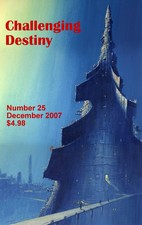


Reviews Home
Columns
Fiction by Title
Fiction by Author
Nonfiction
Movies by Title
Movies by Rating
Audio
Games
Sailing to Sarantium, Guy Gavriel Kay, Viking, 1998, 438 pp.
Note: Sailing to Sarantium is the first book of the The Sarantine Mosaic.
Guy Gavriel Kay is one of our best writers. He began his career, many years ago, helping Christopher Tolkien edit The Silmarillion, and wrote his own Tolkienesque trilogy, The Fionavar Tapestry, as his own first published fantasy. Since then, he has carved out his own distinctive niche, the historical fantasy, over the course of his next three books, Tigana, A Song for Arbonne, and The Lions of Al-Rassan. These three books all stood on their own, complete and self-contained, and the tremendous amount of world-building for each book ended its usefulness at the conclusion. Now with The Sarantine Mosaic, Kay has begun to stretch out into epic length once again, and Sailing to Sarantium feels luxurious as a result. But never slow, and the detail never feels irrelevant; this novel is tightly constructed and still a pleasure to read. The characters feel immediately familiar, and their dilemmas are dramatized effectively.
The story of Sailing to Sarantium is a good one, and grabs the sympathy of the reader with ease. Unfortunately, the lengthy Prologue, while serving as an important introduction to the endpoint of the main character's journey, is a bit of a stumbling block. The Sarantine Emperor has died, and we get a jumble of impressions from a rapid sequence of characters. Only two of them are particularly important, Petrus and his lover Aliana, who will become Emperor and Empress in the intervening time between the Prologue and Chapter One. Chapter One begins the story proper, with an Imperial summons wending its way from Sarantium to the "provincial" city of Varena. The Emperor is summoning a mosaicist named Martinian, but Martinian is old and unambitious, and convinces his younger friend, Crispin, to go in his place. Crispin does so, but not before talking to an old alchemist, Zoticus, and a much more clandestine discussion with Queen Gisel. On his way to Sarantium, he accumulates two companions -- the former slave girl, Kasia, and the thug with a heart of gold, Vargos -- and has a hair-rising encounter with a dark god in the primitive province of Sauradia. Upon arriving in Sarantium, he is immediately thrown into the intense intrigue of the Imperial capital. The novel has a number of astonishing set-pieces, like scenes from the most spectacular and intelligent movie that has never come from Hollywood -- the showdown to save Kasia, the chariot race, and Crispin's first evening at court were my favourites. Sailing to Sarantium functions extremely well as the first book in a two-part series: exciting in its own right, yet leaving the possibilities wide open for the sequel. As a number of characters say, to "sail to Sarantium" is to take enormous risks in the hope of enormous rewards. This is an apt description for Crispin's actions, and an apt way to set up for the next book.
Kay has an excellent grasp of characterization, but he does have a tendency to get distracted by the lives of minor characters. This tendency is less harmful to the book once we have found out who the main characters are. Crispin is one of Kay's better characters: Crispin is talented, impetuous, and quite courageous in his own way. Crispin is also tormented by survivor's guilt, because of the deaths of his wife and two young daughters of the plague the year before the novel opens. He has his work as a mosaicist, but he is still despairing. As he says to Kasia later on: "'I am ashamed to be here. I let them die'" (211). He slowly loses this sense of self-blame as the book progresses, but it is certainly not a gimmick to grab our sympathy -- his pain feels genuine and his psychological problems consistently affect his actions. Crispin's most shining moment is during his first Imperial audience. He demonstrates great wit in the face of intricate layers of machinations -- if you ever wondered, like me, why everyone in a medieval court couldn't just get along, then this scene is a nice shock. I also liked the discussion between Crispin and the Emperor, where the Emperor notes Crispin's puzzle-solving skills, and makes an analogy to his own Imperial doings. Crispin replies, in the lingo of mosaics: "'They are glass and stone, not mortal souls, my lord'" (328). Crispin and his friends are well-chosen as the heart of the book, and ranged around them, Kay places a gallery of Sarantine characters, all credible and artfully represented.
Kay's writing style is as lucid and potent as always. I offer up only one example, one passage that wrings a good deal of pathos out of a solitary image. Kasia's mother sold her into slavery in order to survive the winter. And the image of that day haunts Kasia often when she is least expecting it: "She thought of her mother a year ago, alone on a leaf-strewn path with a small bag of coins in her hands, watching the slave train take her daughter away. It had been a brilliantly clear day, snow gleaming on the mountain peaks, the leaves red and gold, and falling" (157).
Sailing to Sarantium leaves us wanting more, a narrative promise which Kay delivers on in the sequel, Lord of Emperors. Sailing to Sarantium already gives us a fascinating meditation on the nature of power and art, and insight into the lives of those who seek immortality and fame through these two most human of pursuits.
First posted: October 21, 1998; Last modified: March 21, 2004.
Copyright © 1998-2004 by James Schellenberg (james@jschellenberg.com)

Buy back issues of Challenging Destiny online from:
For the latest information on availability: Where Can You Buy Challenging Destiny?